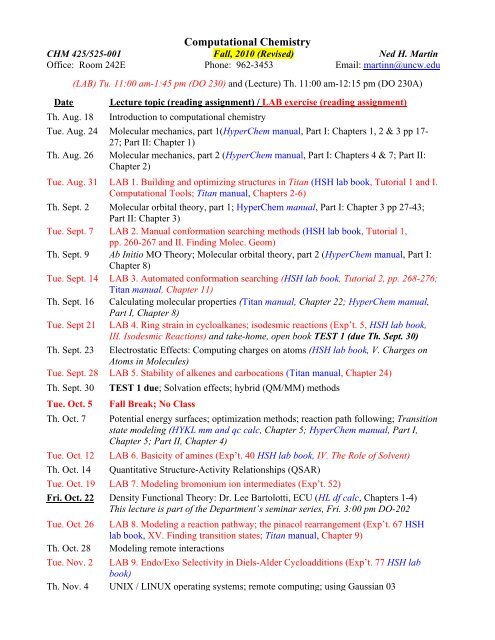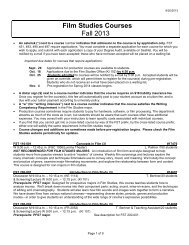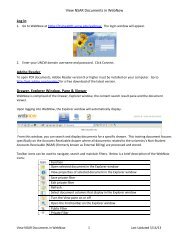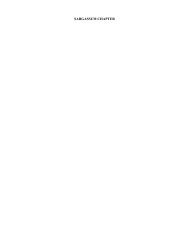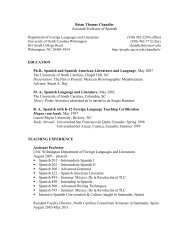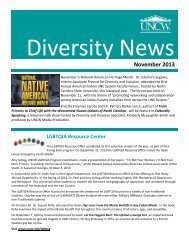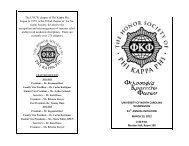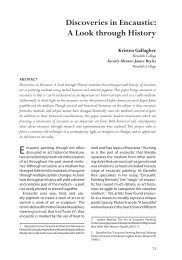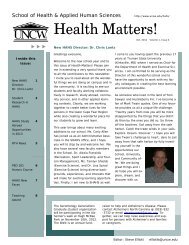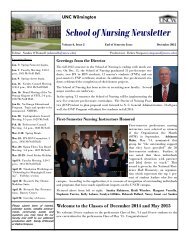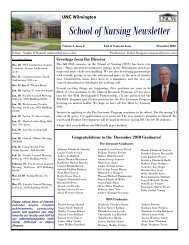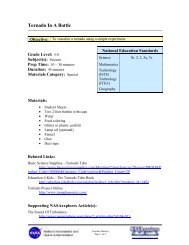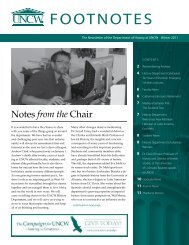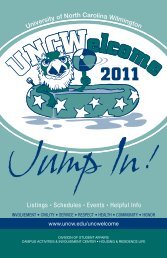You also want an ePaper? Increase the reach of your titles
YUMPU automatically turns print PDFs into web optimized ePapers that Google loves.
<strong>Computational</strong> <strong>Chemistry</strong><br />
CHM 425/525-001 Fall, 2010 (Revised) Ned H. Martin<br />
Office: Room 242E Phone: 962-3453 Email: martinn@uncw.edu<br />
(LAB) Tu. 11:00 am-1:45 pm (DO 230) and (Lecture) Th. 11:00 am-12:15 pm (DO 230A)<br />
Date Lecture topic (reading assignment) / LAB exercise (reading assignment)<br />
Th. Aug. 18 Introduction to computational chemistry<br />
Tue. Aug. 24 Molecular mechanics, part 1(HyperChem manual, Part I: Chapters 1, 2 & 3 pp 17-<br />
27; Part II: Chapter 1)<br />
Th. Aug. 26 Molecular mechanics, part 2 (HyperChem manual, Part I: Chapters 4 & 7; Part II:<br />
Chapter 2)<br />
Tue. Aug. 31 LAB 1. Building and optimizing structures in Titan (HSH lab book, Tutorial 1 and I.<br />
<strong>Computational</strong> Tools; Titan manual, Chapters 2-6)<br />
Th. Sept. 2 Molecular orbital theory, part 1; HyperChem manual, Part I: Chapter 3 pp 27-43;<br />
Part II: Chapter 3)<br />
Tue. Sept. 7 LAB 2. Manual conformation searching methods (HSH lab book, Tutorial 1,<br />
pp. 260-267 and II. Finding Molec. Geom)<br />
Th. Sept. 9 Ab Initio MO Theory; Molecular orbital theory, part 2 (HyperChem manual, Part I:<br />
Chapter 8)<br />
Tue. Sept. 14 LAB 3. Automated conformation searching (HSH lab book, Tutorial 2, pp. 268-276;<br />
Titan manual, Chapter 11)<br />
Th. Sept. 16 Calculating molecular properties (Titan manual, Chapter 22; HyperChem manual,<br />
Part I, Chapter 8)<br />
Tue. Sept 21 LAB 4. Ring strain in cycloalkanes; isodesmic reactions (Exp’t. 5, HSH lab book,<br />
III. Isodesmic Reactions) and take-home, open book TEST 1 (due Th. Sept. 30)<br />
Th. Sept. 23 Electrostatic Effects: Computing charges on atoms (HSH lab book, V. Charges on<br />
Atoms in Molecules)<br />
Tue. Sept. 28 LAB 5. Stability of alkenes and carbocations (Titan manual, Chapter 24)<br />
Th. Sept. 30 TEST 1 due; Solvation effects; hybrid (QM/MM) methods<br />
Tue. Oct. 5 Fall Break; No Class<br />
Th. Oct. 7 Potential energy surfaces; optimization methods; reaction path following; Transition<br />
state modeling (HYKL mm and qc calc, Chapter 5; HyperChem manual, Part I,<br />
Chapter 5; Part II, Chapter 4)<br />
Tue. Oct. 12 LAB 6. Basicity of amines (Exp’t. 40 HSH lab book, IV. The Role of Solvent)<br />
Th. Oct. 14 Quantitative Structure-Activity Relationships (QSAR)<br />
Tue. Oct. 19 LAB 7. Modeling bromonium ion intermediates (Exp’t. 52)<br />
Fri. Oct. 22 Density Functional Theory: Dr. Lee Bartolotti, ECU (HL df calc, Chapters 1-4)<br />
This lecture is part of the Department’s seminar series, Fri. 3:00 pm DO-202<br />
Tue. Oct. 26 LAB 8. Modeling a reaction pathway; the pinacol rearrangement (Exp’t. 67 HSH<br />
lab book, XV. Finding transition states; Titan manual, Chapter 9)<br />
Th. Oct. 28 Modeling remote interactions<br />
Tue. Nov. 2 LAB 9. Endo/Exo Selectivity in Diels-Alder Cycloadditions (Exp’t. 77 HSH lab<br />
book)<br />
Th. Nov. 4 UNIX / LINUX operating systems; remote computing; using Gaussian 03
Tue. Nov. 9 LAB 10. Classical vs. Non-Classical Carbocations; NMR shift and charge<br />
calculations using Gaussian 03 on a remote computer (lab counts double)<br />
Th. Nov. 11 TEST 2<br />
Tue. Nov. 16 LAB 11. Modeling the Relative Acidities of Substituted Phenols (HSH lab book,<br />
IX. Graphical Models and Graphical Modeling)<br />
Th. Nov. 18 WWW <strong>Computational</strong> <strong>Chemistry</strong> Resources; Modeling Biomolecules<br />
Tue. Nov. 23 LAB 10 cont’d Gaussian 03 on a remote computer<br />
Th. Nov. 25 Thanksgiving; No Classes<br />
Tue. Nov. 30 (12:15 pm) Oral Reports on LAB 10. NMR shift and charge calculations and<br />
Introduction to Molecular Dynamics and its Applications (Dr. Hee-Seung Lee)<br />
Tue. Dec. 7 FINAL EXAM 11:30 am – 2:30 pm DO-230A<br />
LAB reports are to be written in MSWord or (preferably) Excel and submitted as an attachment to<br />
email to martinn@uncw.edu no later than one week after the lab is scheduled. Each must be named as<br />
follows: the number of the lab experiment followed by your initials: e.g., 3nhm.xls Ongoing efforts<br />
should be made to improve the readability/usability and appearance of the reports.<br />
Grading:<br />
15 Basic computational chemistry skills 60 points<br />
2 Tests 200 points<br />
11 <strong>Computational</strong> lab reports (#11 counts double) 120 points<br />
Final Exam (comprehensive) 120 points<br />
Total 500 points<br />
(Graduate students must also complete a computational chemistry project with a written report)<br />
90% = A 80% = B 70% = C 60% = D<br />
Texts: (to be loaned to students by instructor; no text needs to be purchased)<br />
HyperChem <strong>Computational</strong> <strong>Chemistry</strong> (HyperChem manual)<br />
TITAN Tutorial and User’s Guide (Titan manual), Wavefunction, Schrodinger, 1999<br />
A Laboratory Book of <strong>Computational</strong> Organic <strong>Chemistry</strong>, (HSH lab book), Warren J.<br />
Hehre, Alan J. Shusterman, W. Wayne Huang, Wavefunction, Irvine, 1996.<br />
A Brief Guide to Molecular Mechanics and Quantum Chemical Calculations, (HYKL mm<br />
and qc calc) Warren J. Hehre, Jianguo Yu, Philip E. Klunzinger, Liang Lou, Wavefunction,<br />
Irvine, 1997.<br />
A Guide to Density Functional Calculations in Spartan, (HL df calc) Warren J. Hehre, Liang<br />
Lou, Wavefunction, Irvine, 1997.<br />
Additional Resources (available in Randall Library):<br />
Introduction to <strong>Computational</strong> <strong>Chemistry</strong>, Frank Jensen, Wiley, Chichester, 1999<br />
Molecular Modeling: Perspectives and Applications, Andrew R. Leach, Addison Wesley<br />
Longman, Harlow, 1996<br />
A Handbook of <strong>Computational</strong> <strong>Chemistry</strong>, Tim Clark, Wiley-Interscience, NY, 1985<br />
Encyclopedia of <strong>Computational</strong> <strong>Chemistry</strong>, (Ref QD 39.3.) Ed. Paul v. R. Schleyer, Wiley,<br />
Chichester, 1998
Learning Outcomes:<br />
Students are expected to have working knowledge of the language of computational chemistry, the<br />
various levels of theory (molecular mechanics, semi-empirical molecular orbital theory, ab initio<br />
molecular orbital theory, correlated methods, and density functional theory. The assessment measure<br />
of these outcomes is success on the hour tests and/or the final exam. Use of Titan softweare to perform<br />
fundamental operations in computational chemistry will be assessed by lab reports and by performance<br />
on the mastery skills tests.<br />
Academic Integrity:<br />
All members of UNCW’s community are expected to follow the academic Honor Code. Please read<br />
the UNCW Honor Code carefully (as covered in the UNCW Student Handbook). Academic<br />
dishonesty in any form will not be tolerated in this class.<br />
Students with Disabilities:<br />
Students with diagnosed disabilities should contact the Office of Disability Services (962-7555).<br />
Please give me a copy of the letter you receive from Office of Disability Services detailing class<br />
accommodations you may need. If you require accommodation for test-taking please make sure I have<br />
the referral letter no less than three days before the test.<br />
Violence and Harassment:<br />
UNCW practices a zero tolerance policy for any kind of violent or harassing behavior. If you are<br />
experiencing an emergency of this type contact the police at 911 or UNCW CARE at 962-2273.<br />
Resources for individuals concerned with a violent or harassing situation can be located at<br />
http://www.uncw.edu/wsrc/crisis.html<br />
Campus Respect Compact:<br />
UNCW has recently instituted a Respect Compact to affirm our commitment to a civil community,<br />
characterized by mutual respect. That Compact will soon be affixed to the wall of each classroom and<br />
can be accessed at: http://www.uncw.edu/stuaff/pdc/documents/SeahawkRespectCompact.pdf<br />
Individuals wanting more information about the respect Compact can contact the Office of Institutional<br />
Diversity and Inclusion.<br />
Use of electronic devices during class:<br />
Cell phone use will not be tolerated in this class. Turn off your cell phones prior to class. If your cell<br />
phone rings, Dr. Martin will answer it for you. You do not want this to happen. No ipods or other<br />
listening devices may be used during class or exams. Laptops may be used in this class, but only for<br />
following PowerPoint presentations or note-taking. No web surfing, texting or email access is allowed<br />
during class time.


